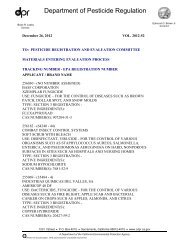Dichlorvos (DDVP) Risk Characterization Document - California ...
Dichlorvos (DDVP) Risk Characterization Document - California ...
Dichlorvos (DDVP) Risk Characterization Document - California ...
You also want an ePaper? Increase the reach of your titles
YUMPU automatically turns print PDFs into web optimized ePapers that Google loves.
soluble <strong>DDVP</strong> derivatives. Other metabolites included inorganic phosphate, two-carbon fragments<br />
(glycine and serine), phosphate ions, and chloride ions.<br />
Rats (strain not specified) were given <strong>DDVP</strong> ( 14 C and 36 Cl, purity not specified; 0.99 mg/male rat and<br />
0.72 mg/female rat) by gavage (Hutson et al., 1971). Urine, feces, and exhaled air were collected<br />
every day for 4 days. Radioactivity in tissues was also determined. Additional female rats were used<br />
for the determination of metabolites in the urine and the liver. There was no difference in the<br />
excretion patterns between sexes. After 4 days (daily result not given), the percentages of<br />
administered doses in the urine, feces, and exhaled air were 12.8-18.2%, 3.4-4.8%, 36.8-38.8%,<br />
respectively. The identified urinary metabolites included hippuric acid (8.3% of total urinary<br />
radioactivity), desmethyl-<strong>DDVP</strong> (10.9%), and 2,2-dichloroethyl-B-d-glucopyranosiduronic acid (27%),<br />
while no unmetabolized <strong>DDVP</strong>, dichloroacetaldehyde or dichloroacetic acid was found. Of the tissues<br />
examined, the highest level of radioactivity (4.4-5.0% of dose) was in the liver. Analysis of the liver<br />
tissue showed that 75% of the radioactivity was associated with glycine, serine, and cystine in the<br />
protein hydrolysate fraction.<br />
Rats (Crl:CD (SD) BR) were given <strong>DDVP</strong> ( 14 C, purity not specified) either as a single intravenous dose<br />
(1 mg/kg), by gavage as a single dose (0.8 mg/kg or 21 mg/kg), or by gavage as multiple doses (0.8<br />
mg/kg) for 16 days (Cheng, 1989 and 1991). Radioactivity in the tissues and carcasses was<br />
determined 7 days after dosing. Urine, feces, and exhaled air as CO 2 were monitored for 7 days after<br />
dosing. Clinical signs, such as tremors and salivation, were observed 2.5 hours after gavage dosing<br />
in the 21 mg/kg group. There were no differences in the tissue distribution and excretion patterns<br />
between the dosing regiment or sexes. Consistent with the earlier studies, the liver and kidneys<br />
contained higher levels of radioactivity than other organs (lung, spleen, uterus, and bone). For both<br />
routes of administration, the percent of total dose excreted ranged from 40 to 58% in the exhaled air,<br />
10-17% in the urine, and 4-7% in the feces. The majority of the radioactivity in the exhaled air and<br />
excreta was eliminated within 24 hours after dosing. The major metabolites in the urine and feces<br />
were hippuric acid and urea. Glucuronide conjugates and other dehalogenated products were not<br />
positively identified.<br />
Intravenous - Rat<br />
Rats (Carworth Farm strain E) were given <strong>DDVP</strong> (purity not specified, 0.83 mg/kg) by intravenous<br />
injection (Blair et al., 1975). <strong>DDVP</strong> was distributed primarily in the kidneys. Levels in the other tissues<br />
(blood, liver, fat, testes, and brain) were 0.01 to 0.1 ug/g, at the limits of detection for the analysis<br />
method used. <strong>DDVP</strong> degradation in the kidneys was rapid as the levels decreased from 1.44-2.25<br />
ug/g at 10 minutes to 0.15-0.80 ug/g at 30 minutes after dosing.<br />
The kinetics after intravenous administration to rats (Crl:CD (SD) BR) was similar to those for gavage<br />
dosing (Cheng, 1989 and 1991) (see discussion under Oral - Rat section).<br />
Intraperitoneal - Rat<br />
The kinetics of <strong>DDVP</strong> in the rat (strain not specified) after intraperitoneal administration followed<br />
similar kinetics as those for the oral route (Casida et al., 1962). However in the study conducted by<br />
Hutson et al. (1971), the amount of radioactivity in the urine (35.0% of dose) was higher than that for<br />
exhaled air (18.6%). The major metabolite in the urine was dichloroethanol glucuronide, with hippuric<br />
acid and desmethyl <strong>DDVP</strong> as minor metabolites.<br />
11
















